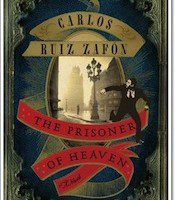The latest novel by Spanish writer Carloz Ruiz Zafón opens on a cold winter’s day in Barcelona. Business is abysmal at Sempre & Sons bookshop. The Sempre family’s loquacious friend, Fermín Romero de Torres, offers to parade in his underwear by the bookstore window to incite “strong literary emotions” from females passing by. Thus begins Zafón’s venture into The Prisoner of Heaven, the third part of his multimillion-selling literary series.
Zafron’s previous samplings, The Shadow of the Wind and The Angel’s Game, are neither prequels nor sequels to this third installment. Zafón has created a labyrinth of stories, free from chronology, with intertwining characters, locations, themes, and storylines. All three novels revolve around an occult library beneath the streets of Barcelona, the Cemetery of Forgotten Books. The novels are gothic, stylized, romantic tales driven by passion for the written word.
The protagonist of The Angel’s Game is a journalist-turned-novelist who sells his soul for the love of writing. The Prisoner of Heaven continues that theme of the publishing industry’s shadowy deviance, adding to it the criticism of Spanish literary circles. The Shadow of the Wind chronicles the adventures of a young reader, Daniel, the son of Sempre & Sons bookshop owner. The Prisoner of Heaven subsequently unfolds layers of Daniel’s story. But it also explores Fermín’s dark past as a Catalonian intelligence agent, imprisoned in the Montjuic Castle for espionage.
Like all of Zafón’s stories, this one draws symbolism and parallels from a classic work of literature. The Prisoner of Heaven’s is The Count of Monte Cristo. In this third installment Fermín meets David Martín, the protagonist of The Angel’s Game, while in prison. They use the classic tale by Dumas as code. Together the two literature lovers, Fermín and David, plan an escape. In the Montjuic Castle we find how all of the characters’ of Zafón’s stories are connected through a single villain, Valls.
Valls is an aspiring writer, without talent or modesty, who rose to power through marriage, murder, and connections during the Spanish Civil War in the 1930s. With a sadistic ego, Valls begins his political ascent as director of the prison in Montjuic Castle. The Prisoner of Heaven is Zafón’s most blatantly political and historical work so far, but it is all still couched securely in fiction by the familiar, dramatic exaggeration in Zafón’s prose.
In the Montjuic Castle, Valls tortures David Martín, driving him insane with emotional blackmail, and forcing him to write a masterpiece that Valls can publish for fame and fortune. In that state – threatened, imprisoned and stricken with mania – David writes his final book, his story, The Angel’s Game. We discover their twisted history when Fermín tells Daniel the shocking truth about his parentage.
The characters surrender their darkest secrets too easily in The Prisoner of Heaven. This is one of its weaknesses as a novel, along with its cliffhanger ending. This third installment is the sole book that cannot easily stand alone. Zafón offers his readers no neatly wrapped closure this time.
The Prisoner of Heaven is an ode to the city of Barcelona. The scenes are visually built with the mise en scéne of film noir, courtesy of Zafón’s time as a screenwriter in Los Angeles. “A scarlet sky curved over Barcelona,” Zafón writes. “The city looked dark, entwined with sharp, black silhouettes.” It has its own personality and story. Zafón shows us Barcelona through his eyes.
Characters exchange long, witty banter with all the sagacity and discernment of Oscar Wilde and Gabriel Garcia Márquez’s love of poetic prostitutes with hearts of gold. The story is riddled with skillful inversions of familiar detective story gimmicks: novice detectives with convenient luck and nefarious caricatures. Literature and mystery are described with scathingly eloquent syntax. Reading it reminds us how the temptation to worship words can become, just as Zafón’s characters reveal, the most noble and dangerous of sins.




